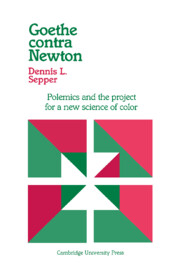Book contents
- Frontmatter
- Contents
- Preface
- List of abbreviations
- 1 Defining the questions of the Farbenlehre
- 2 The Farbenlehre in its origin
- 3 The problematics of Newton's theory of white light and colors
- 4 Factuality, certainty, and the organization of science
- 5 Goethe and the ethos of science
- Appendix
- Notes
- References
- Index
- Frontmatter
- Contents
- Preface
- List of abbreviations
- 1 Defining the questions of the Farbenlehre
- 2 The Farbenlehre in its origin
- 3 The problematics of Newton's theory of white light and colors
- 4 Factuality, certainty, and the organization of science
- 5 Goethe and the ethos of science
- Appendix
- Notes
- References
- Index
Summary
Two aspects of Goethe's Farbenlehre have historically produced great confusion – his contention that white light, pure and simple in itself, must be darkened if it is to produce colors; and his attempt to elucidate the phenomena of refractive colors (FL-D, par. 218–42) on the basis of his doctrine of the trübes Mittel (FL-D, par. 145–77). Goethe's teaching about white light is treated briefly at the end of Chapter 3; the present appendix is concerned chiefly with the doctrine of refractive colors.
What is a trübes Mittel? If we translate by cognates we would say “turbid medium.” The problem with this, however, is that turbid has stronger connotations of dark and muddy than does trüb, which is rather more akin to cloudy or milky, perhaps even semitranslucent. A trübes Mittel is, in the first instance, a semitranslucent medium. Goethe introduces the term to describe the beginning of opacity in an otherwise transparent medium. We can imagine empty space without matter; this space would be perfectly transparent. As soon as we introduce matter, however – for example, by releasing into the space a small amount of colorless gas – we encounter the first degree of nontransparency; ever greater amounts of the gas would begin to produce a noticeable dimming of a light shining through it.
- Type
- Chapter
- Information
- Goethe contra NewtonPolemics and the Project for a New Science of Color, pp. 196 - 200Publisher: Cambridge University PressPrint publication year: 1988



